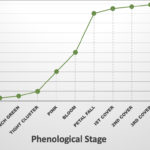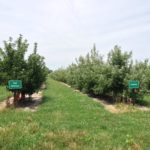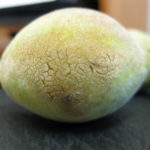“Timing is everything.” No truer statement has ever been uttered, especially in the orchard, where the timing of fungicide sprays from “pink” (bud stage) through petal fall requires an almost psychic ability to anticipate pesticide timings. Abundant ascospores production occurs at pink and continues through petal fall, increasing the risk of infection until petal fall through first cover (Fig. 1). Although primary infections no longer occur by first cover, any ascospores (primary infections) that successfully infected the apple tree have the potential to create a tremendous number secondary infections. Therefore, protection during bloom is protection during the peak period of susceptibility. The timing of this protection is then coupled with another phenological event, petal fall. These timings need to be anticipated so that trees are fully protected through bloom but are due for another fungicide spray to combine with the necessary insecticide sprayed at petal fall to control curculio and leafroller hatch. Factoring this timing is difficult enough—factoring the unpredictable arrival of petal fall to correctly time your spray may prove beyond your “psychic ability.” “Stretching” spray timing just a few days so one can reach petal fall can be a costly mistake if trees are left unprotected during critical bloom-time infection periods, but understanding how to best deploy fungicides can help keep you covered until first cover.
Prior to peak spore release periods (Fig. 1), protect trees prior to the anticipated petal fall spray by applying mancozeb or captan, or captozeb (3-5 day ideally, but 7 days in reality, 10 if spring is really, really dry) when the risk of infection is lower. Thorough coverage is easily achieved through tight cluster, but becomes much more difficult as trees more fully leaf out and more ascospores are being released. Early on, repeated applications of captan and/or mancozeb are essential to protect new growth; other options include the FRAC 9 fungicides Scala and Vanguard which provide good protection during cooler periods of lower scab pressure. Other options include Syllit (FRAC M), prior to pink and the FRAC 7 fungicides (Aprovia, Fontelis, Sercadis) from half-inch green through pink.
To improve protection when there is more plant tissue to protect AND a higher spore load, use the systemic fungicides. The FRAC 3 fungicides have been around for so long that we have a new generation of them, including Cevya, Inspire, Topguard, and Indar to provide greater scab control than the FRAC 3 fungicides that preceded them (Rubigan, Nova, or Procure). These newer FRAC 3 fungicides have more intrinsic activity against apple scab (and protect against powdery mildew and rust) and once again provide the flexibility for timing sprays compared to the first generation FRAC 3, and the traditional contact fungicides (mancozeb, captan, polyram, or ziram). We know that fungicide resistance is inevitable, which means we still need to apply FRAC 3 fungicides strategically and within 24-48 hr of infection if we wish to best control scab and minimize the risk of resistance.
Good control going into pink and bloom with protectant fungicides early also preserves the FRAC 11 fungicides for the pink through petal fall period when multiple fungal pathogens like rust, powdery mildew and bitter rot begin their infection cycle. This is also the period of time when scab is reaching maximum ascospore release and the beginning of powdery mildew, rust and bitter rot. In years with a very extended bloom period, this approach allows the alternation of FRAC 3(Cevya, Inspire, Topguard, Indar, Rally) with FRAC 11 (Flint Extra, Sovran) or a FRAC 7+11 (Luna Sensation, Merivon, Pristine). Be careful using the FRAC 7+11 fungicides if you relied upon the FRAC 7s (Aprovia, Fontelis, Sercadis) earlier in the season.
Peaches
Assuming that your peaches have made it this far, the biggest worry for them and other stone fruit is brown rot (Fig. 2). Brown rot control needs to begin at pink and peach scab control needs to be added to that around petal fall. Both fungal diseases need to be managed throughout the season until harvest. Mummy removal, pruning out cankers, good orchard sanitation, and timely application of fungicide, especially after rains exceeding 2” are essential for control of both diseases. Both brown rot and peach scab are capable of producing spores now; keeping trees protected with fungicide during wet periods is essential to bringing the crop to harvest. The worst thing about these two pathogens is that the symptoms and signs of these disease seem to appear suddenly around harvest; in reality, the infection process often began two months ago (meaning as you are reading this now!). See the 2020 Midwest Fruit Pest Management Guide https://ag.purdue.edu/hla/Hort/Documents/ID-465.pdf for more information regarding peach disease management.
Final note:
“Upticks in powdery mildew last year, plus a mild winter (which allows the fungus to overwinter in buds) set the stage for powdery mildew on both pome and stone fruit crops (Fig. 3,4). Powdery mildew is active during dry periods above 50 degrees and below 90, but happiest on dry, mild, spring days. Keep an eye on the most susceptible apple varieties (Jonathan, Baldwin, Ginger Gold, Ida Red, Cortland, Rome, Stayman Winesap). We continue to observe an uptick of PM on our Honeycrisps last year, so keep an eye on them, too! Remember that captan and mancozeb are not effective for controlling this disease, but FRAC 3 fungicides (Rally, Topguard, Indar, Cevya), FRAC 7 (Fontelis, Sercadis) FRAC 11 (Flint, Sovran), and FRAC 7+11 (Pristine, Merivon, Luna Sensation) are good to excellent on powdery mildew and most will help with rust and scab for apples, or brown rot and peach scab in peaches, assuming resistance is not an issue! Note: Aprovia is not labeled for stone fruit at this time.
- Fig 1 Risk of apple scab infection at each phenological stage.
- Fig 2 Brown rot of peach.
- Fig 3 Powdery mildew is a problem in dry springs, especially on susceptible varieties. I would still rather not eat a Red Delicious, though!
- Fig 4 Powdery mildew on peaches.
2020 apple disease management guide




